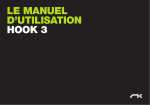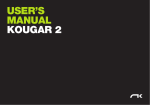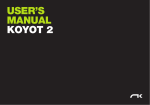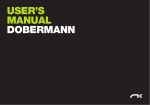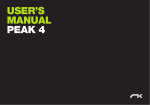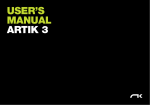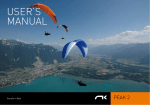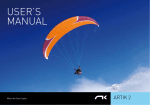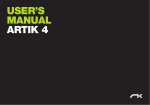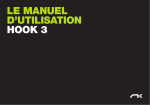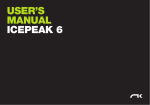Download USER`S MANUAL HOOK 3
Transcript
USER’S MANUAL HOOK 3 HOOK 3 Passion & evolution NIVIUK Gliders HOOK 3 WELCOME This manual offers all the necessary information that will familiarize you with the main characteristics of your new paraglider. Although this manual informs you about your glider, it does not offer the instruction requirements necessary for you to be able to pilot this type of wing. Flying instruction can only be taught at a paragliding school recognised by the Flying Federation of your country. We wish to welcome you to our team and thank you for the confidence that you have placed in a NIVIUK Glider. We would like to share with you the commitment, the passion and emotions of the Niviuk design team, which have resulted in the creation of the new HOOK 3. Niviuk are very proud of this new glider, a glider carefully designed to bring you maximum pleasure whilst allowing you learn and progress. The HOOK 3 has born from Niviuk essence, our tradition and from our experience from the past and future’s innovation. Versatile and ultramodern, the HOOK 3 offers an excellent piloting experience, adventure to the highest extent, comfort in flight and efficiency. It’s the change from the usual to the extraordinary. The HOOK 3 does not leave anything else to wish for. We are confident that you will enjoy flying this wing and that you will soon understand the meaning of our slogan: “The importance of small details” This is the user’s manual that we recommend you to read in detail. The NIVIUK Gliders Team. NIVIUK GLIDERS C/ DEL TER 6, NAVE D 17165 LA CELLERA DE TER - GIRONA - SPAIN TEL. +34 972 42 28 78 FAX +34 972 42 00 86 [email protected] www.niviuk.com 2 USER’S MANUAL Nevertheless we remind you that it is important that you carefully read all the contents of the manual for your new HOOK 3. Severe injuries to the pilot can be the consequence of the misuse of this equipment. SUMMARY WELCOME2 5. LOSING HEIGHT 10 USER’S MANUAL 2 5.1 EARS 10 1. CHARACTERISTICS 4 5.2 B-LINE STALL 10 1.1 WHO IS IT DESIGNED FOR? 4 5.3 SPIRAL DIVE 11 1.2 CERTIFICATION 4 5.4 SLOW DESCENT TECHNIQUE 11 1.3 IN-FLIGHT BEHAVIOUR 4 6. SPECIAL METHODS 11 1.4 ASSEMBLY, MATERIALS 4 6.1 TOWING 11 1.5 ELEMENTS, COMPONENTS 5 6.2 ACROBATIC FLIGHT 11 2. UNPACKING AND ASSEMBLY 5 7. FOLDING INSTRUCTIONS 12 2.1 CHOOSE THE RIGHT PLACE 5 8. CARE AND MAINTENANCE 12 2.2 PROCEDURE 5 8.1 MAINTENANCE 12 2.3 ASSEMBLY OF THE HARNESS 5 8.2 STORAGE 12 2.4 TYPE OF HARNESS 5 8.3 CHECKS AND CONTROLS 12 2.5 ASSEMBLY OF THE ACCELERATOR 6 8.4 REPAIRS 12 9. SAFETY AND RESPONSIBILITY 13 6 10. GUARANTEE 13 2.7 ADJUSTING THE BRAKES 6 11. TECHNICAL DATA 14 3. THE FIRST FLIGHT 6 11.1 TECHNICAL DATA 14 3.1 CHOOSE THE RIGHT PLACE 6 11.2 MATERIALS DESCRIPTION 15 3.2 PREPARATION 6 11.3 RISER ARRANGEMENT 16 3.3 FLIGHT PLAN 7 11.4 LINE PLAN 17 3.4 PRE-FLIGHT CHECK LIST 7 11.5 LENGTHS HOOK 3 21 18 11.6 LENGHTS HOOK 3 23 18 7 11.7 LENGHTS HOOK 3 25 19 3.6 LANDING 7 11.8 LENGHTS HOOK 3 27 19 4. IN FLIGHT 7 11.9 LENGHTS HOOK 3 29 20 4.1 FLYING IN TURBULENCE 7 11.10 CERTIFICATION SPECIMEN 21 4.2 POSSIBLE CONFIGURATIONS 7 4.3 USING THE ACCELERATOR 9 4.4 FLYING WITHOUT BRAKE LINES 9 4.5 KNOTS IN FLIGHT 9 2.6 INSPECTION AND WING INFLATION ON THE GROUND 3.5 WING INFLATION, CONTROL, AND TAKE-OFF 3 1. CHARACTERISTICS 1.1 WHO IS IT DESIGNED FOR? The HOOK 3 has been clearly designed for pilots that aim for the best: independence, freedom and adventure. At Niviuk we have very clear that the most important element of the glider is the pilot. That’s why our new HOOK 3 has a single objective: the personal growth of the pilot. Its high performance and high level of comfort in flight will let you choose between a flight with a sporty character or an astonishing serene flight. You are in charge of setting the pace. Let your emotions soar with the Hook 3. 1.2 CERTIFICATION The HOOK 3 has successfully achieved the European EN B and the LTF 1-2 certifications. Description of flight characteristics on B class: Paraglider with good passive safety and forgiving characteristics. High resistance to departures from normal flight. Description on pilots skills required on B class: Designed for all pilots including pilots under all levels of training. The HOOK 3 passed the essential load test of 8G without experiencing any problems. On the flight test all the five sizes of the HOOK 3 received the best certification EN B. This test was carried out in the Swiss Air-Turquoise laboratories. Check the certification results and figures on the last pages of this manual or at www.niviuk.com 4 1.3 IN-FLIGHT BEHAVIOUR In order to bring you the best glider in this class the NIVIUK Team have carried out extensive and meticulous design work. As a consequence of several prototypes and many hours of test flights numerous adjustments were made. These prototypes were then tested in all types of flight conditions. HOOK 3 is the result. Hook 3 is technology privileged compared to its predecessors, the wing features a new profile with performance and technologies transmitted down from the competition wings. Improvements and innovations that Olivier and our R&D team manage to move from competitions all around the world to the new HOOK 3, for you to enjoy it. In spite of evolution, the HOOK 3 is a (safe/ EN B ) glider and it will provide you what is expected of it. Hook 3 is a glider for all pilots who wish to be equipped with latest performance and technology; it is capable to offer the same usual safety, the same feeling with closed eyes and the same coherence with the original NIVIUK ideas. 1.4 ASSEMBLY, MATERIALS The HOOK 3 does not only introduce new design methods but also new manufacture technologies. Not a single millimetre of error is possible in the manufacturing process from Olivier’s computer to the cutting of the fabric. An automatic process controlled by a laser-cutting program cuts each of the sections that compose the different parts of the wing. This program not only cuts the pieces of fabric but it also paints the guideline marks that will aid the assembly; it also numbers the separate pieces of material. All this is carried out before human handling of the pieces begins. So we eliminate possible and understandable errors that may occur during this delicate procedure. The lines are semi-automatically manufactured and all the sewing is finished under the supervision of our specialists. The jigsaw puzzle of the assembly process is made easier using this method. We minimise the processes while making the quality control more efficient. All the different parts of the canopy are cut and assembled under the strict conditions induced by the automation of the whole process. All NIVIUK Gliders go through an extremely thorough and efficient final inspection. Every single line of each glider is measured individually once the final assembly has concluded. Each wing is then individually inflated for the last visual revision. Each glider is packaged following the maintenance and conservation instructions recommended for the advanced materials. NIVIUK Gliders are made of first class materials as demanded by the performance, durability, and homologation requirements of the present-day market. Information about construction materials is given on the last pages of this manual. 1.5 ELEMENTS, COMPONENTS The HOOK 3 is delivered to its owner together with a series of components that, although not fundamental, do take an important part in the use, transport and storage of the paraglider. The glider is delivered together with a rucksack, large enough for all of the equipment to fit inside, once appropriately packed. The rucksack is designed to make transport on foot as pleasant as possible. The internal bag, intended to protect the HOOK 3 from possible damage, during storage is also supplied. The glider strap allows you to fold the wing as small as possible. Furthermore you will find the accelerator bar that completes the acceleration gear of the wing, a small fabric repair kit made of auto adhesive rips top, a user’s manual with the answers all our questions about our new HOOK 3, an instruction booklet and also a USB pen drive. 2.UNPACKING AND ASSEMBLY 2.1 CHOOSE THE RIGHT PLACE We recommend that you unpack and assemble your wing on a schooling slope or a flat clear area without too much wind and free of obstacles. These conditions will allow you to carry out all the steps required for you to check and inflate the HOOK 3. We recommend that an instructor or a retailer supervises the entire procedure as only they are competent to resolve any doubt in a safe and professional way. 2.2 PROCEDURE Take the paraglider out of the rucksack, open it and spread it open, with the lines on top of the underside, position the wing as if you were to inflate it. Check the condition of the fabric and the lines, make sure there are no abnormalities. Check the maillons that attach the lines to the risers are properly closed. Identify and order the A, B, C lines, the brake lines and the corresponding risers. Make sure that there are no ties or knots. 2.3 ASSEMBLY OF THE HARNESS Correctly place the risers on the harness karabiners. The risers and lines should not have any twists and they should be in the right order. Check that the harness buckles are correctly locked. 2.4 TYPE OF HARNESS The HOOK 3 has passed the EN B certification using a EN1651:1999 type harness. This certification allows it to be flown with most of the harnesses on the market, even the ones that use cocoon. 5 We recommend that you adjust the distance of the chest strap according the homologation from 42 to 50 cm between the harness carabineers. This adjustment will offer the top compromise between safety and feelings. Any change made to these specifications may affect the wing’s performance and reactions. This would therefore effect the glider’s configuration and would not conform to the homologation. 2.5 ASSEMBLY OF THE ACCELERATOR The acceleration mechanism of the HOOK 3 works when you push with your feet on the accelerator bar, this is supplied with the equipment. On delivery the accelerator bar has not yet been installed and it is recommended that it is fit by you before flight. Most harnesses are equipped with a pre-installed acceleration system. When fitting any accelerator system ensure that all preinstalled items within the harness, such as roller pulleys are used correctly. After fitting, take into account that you will have to adjust the length of the accelerator lines for correct use. This will vary according to the length of the pilot’s legs! We recommend that you try the correct fitting of the acceleration system on equipment designed to do this, most paragliding schools have this sort of equipment. 2.7 ADJUSTING THE BRAKES The length of the main brake lines is adjusted at the factory to the length established during homologation. However, the length can be changed to adapt to the pilot’s flying style. Nevertheless, we recommend that you fly for a while with these, set at the original length. This will allow you to become accustomed to the HOOK 3’s original flying behaviour. If you then decide to change the length of the brake lines, untie the knot, slide the line through the brake link to the desired length, and strongly re-tie the knot. Qualified personnel should carry out this adjustment. You must ensure that this adjustment does not slow down the glider without any pilot input. Both brake lines should be symmetrical and measure the same length. The most recommended knots are the clove hitch knot or bowline knot. When changing the brakes length, it is necessary to check that they do not act when the accelerator is used. When we accelerate the glider rotates over the C riser and the trailing edge elevates. We must check that the brake is adjusted taking in consideration this extra length in acceleration. 3. THE FIRST FLIGHT 2.6 INSPECTION AND WING INFLATION ON THE GROUND 3.1 CHOOSE THE RIGHT PLACE Once you have checked all the equipment and made sure that the wind conditions are favourable, inflate your HOOK 3 as many times as necessary in order to become acquainted with the wing’s behaviour. The HOOK 3 inflates easily and smoothly. An excess of energy is not necessary and the wing will inflate with minimum pressure on the harness when you move forward. This may be assisted by using the A lines. Do not pull on them, just lift to accompany the natural rising movement of the wing, once the wing is in the 12 o’clock position, simply apply correct pressure on the brake lines and the HOOK 3 will sit over your head. 6 We recommend that the first flight with your HOOK 3 is made on a smooth slope (a school slope) or in your usual flying area. 3.2 PREPARATION Repeat the procedures detailed in chapter 2 UNPACKING AND ASSEMBLY in order to prepare your equipment. 3.3 FLIGHT PLAN 3.6 LANDING Draw out a flight plan before take-off in order to avoid possible flight errors. The HOOK 3 lands excellently, it transforms the wing speed into lift on the pilot’s demand, allowing an enormous margin of error. You will not have to wrap the brake lines around your hand to get greater braking efficiency. 3.4 PRE-FLIGHT CHECK LIST Once you are ready, but before you take-off, carry out another equipment inspection. Ensure correct installation of all equipment and that all lines are free of hindrances or knots. Check that the weather conditions are suited for your flying skills. 3.5 WING INFLATION, CONTROL, AND TAKE-OFF Smoothly and progressively inflate the wing (chapter 2.6 INSPECTION AND WING INFLATION ON THE GROUND). The HOOK 3 inflates easily and does not require excessive energy. It does not tend to over-take you, so the wing inflation phase is carried out without anguish. These take off characteristics provide a perfect control phase and enough time for the pilot to decide whether to accelerate and take off. Whenever the wind speed allows it, we recommend a reverse launch technique; this type of launch allows you to carry out a better visual check of the wing. The HOOK 3 is especially easy to control in this position in strong winds. However, wind speeds up to 25 to 30 km/h are considered strong and extra consideration should be given to any thought of flight. Preparation and positioning of the wing on the take off is especially important. Choose a location which is appropriate for the direction of the wind. Position the paraglider as if it were part of a large circle, taking into account the shape of the canopy in flight. All this will assist in a trouble free take-off. 4. IN FLIGHT 4.1 FLYING IN TURBULENCE The HOOK 3 complies with an excellent homologation to face this type of situation with the best safety guarantee. This wing is stable in all types of weather conditions. It reacts admirably in passive flight, thus offering a high level of safety in turbulent conditions. Nonetheless, all paragliders always have to be piloted according to the prevailing weather conditions; the pilot is the ultimate safety factor. We recommend that the pilot adopts a proactive attitude when flying, making the necessary fine adjustments to keep the wing in control. He/ she should stop braking to allow it to fly at the required wing speed after a correction is made. Do not maintain any correction for longer than necessary (braked) this would cause the wing to enter into critical flying situation. Whenever necessary, control a situation, react to it and then reestablish the required speed. 4.2 POSSIBLE CONFIGURATIONS We recommend that training to master these manoeuvres be carried out under the supervision of a competent school. Asymmetric collapse In spite of the great stability of the profile of the HOOK 3, heavy turbulent conditions may cause part of the wing to collapse asymmetrically. This usually happens when the pilot has not foreseen this possible reaction 7 of the wing. When the wing is about to experience an asymmetric collapse the brake lines and the harness will transmit a loss of pressure to the pilot. To prevent the collapse from happening, pull the brake line corresponding to the compromised side of the wing, this will increase the angle of incidence. If the collapse does happen the HOOK 3 will not react violently, the turn tendency is very gradual and it is easily controlled. Lean your body towards the side that is still flying in order to counteract the turn and to maintain a straight course, if necessary slightly slow down the same side. The collapse will normally open by itself but if that does not happen, pull completely on the brake line on the side which has collapsed (100%). Do this with a firm movement. You may have to repeat this operation to provoke the re-opening. Take care not to over-brake on the side that is still flying (turn control) and when the collapse has been solved; remember to let the wing recover its flying speed. Symmetric collapse In normal flying conditions the design of the HOOK 3 ensures that a symmetric collapse is quite improbable. The profile of the wing has been designed to widely tolerate extreme changes in the angle of incidence. A symmetric collapse may occur in heavy turbulent conditions, on entry or exit of strong thermals or lack of adapting the use of the accelerator to the prevailing air conditions. Symmetrical collapses usually re-inflate without the glider turning but you can symmetrically apply the brake lines with a quick deep pump to quicken the re-inflation. Release the brake lines immediately to recover optimum flight speed. Negative spin This configuration is out of the normal flight behaviour of the HOOK 3. Certain circumstances however, may provoke this configuration such as trying to turn when the wing is flying at very low speed (while heavily braking). It is not easy to give any recommendations about this situation since it varies depending on the circumstances. Remember that you should restore the relative air speed over the wing. To achieve this, progressively reduce the pressure on the brake lines and let the wing gain speed. The normal reaction would be a lateral surge with a 8 turn tendency no greater than 360º before restoring to normal flight conditions. Parachutal stall The possibility of this happening has been eliminated by the design of the HOOK 3 and it is highly unlikely to happen on this paraglider. If it does happen, the feeling would be that the wing would not be advancing; you would feel a kind of instability and a lack of pressure on the brake lines, although the canopy would appear to be correctly inflated. The correct reaction would be to release the pressure on the brake lines and push the A lines forward or rather lean your body to any side WITHOUT PULLING ON THE BRAKE LINES. Deep Stall The possibility of the HOOK 3 falling into this configuration is almost nonexistent, if the factory settings have not been altered. This could happen if you are flying at a very low speed, whilst over steering in a number of manoeuvres and in turbulent conditions. To provoke a deep stall you have to take the wing to minimum flight speed by symmetrically pulling the brake lines, when you reach this point, continue pulling until you reach 100% and then hold. The glider will first fall behind you and then situate itself above you, rocking slightly, depending on how the manoeuvre was carried out. When you start to provoke a stall, be positive and do not doubt an instant. Do not release the brake lines when half way through the manoeuvre. This would cause the glider to surge violently forward with great energy and may result in the wing below the pilot. It is very important that the pressure on the brake lines is maintained until the wing is well established vertical above. To regain normal flight conditions, progressively and symmetrically release the brake lines, letting the speed be re-established. When the wing reaches the maximum advanced position ensure that the brakes are fully released. The wing will now surge forward, this is necessary so that air speed is completely restored over the wing. Do not over brake at this point because the wing needs to recover speed to quit the stall configuration. If you have to control a possible symmetrical front stall, briefly and symmetrically pull on the brake lines and let go even when the wing is still ahead of you. Wing tangle Of all the possible situations, which you may encounter while flying the HOOK 3, this is the least probable one of all. The well proportioned ratio and well calculated positioning of the line cascades ratify this fact. A wing tangle may happen after an asymmetric collapse, the end of the wing is trapped between the lines (Cravat). This situation could rapidly cause the wing to turn, although it depends on the nature of the tangle. The correction manoeuvres are the same as those applied in the case of an asymmetrical collapse, control the turn tendency by applying the opposite brake and lean your body against the turn. Then locate the line that reaches the stabiliser that is trapped between the other lines. This line has a different colour and belongs to the external lines of the C riser. Pull on this line until it is tense, this should help to undo the wing tangle. If you cannot undo the tangle, fly to the nearest possible landing spot, control the flying course with your body movements and a little pressure on the opposite brake. Be careful when attempting to undo a tangle if you are flying near a mountainside or near to other paragliders, you may lose control of the flying course and a collision may occur. Over handling Most flying incidents are caused by wrong actions of the pilot, which chained one after another create abnormal flying configurations (a cascade of incidents). You must to remember that over handling the wing will lead to critical levels of functioning. The HOOK 3 is designed always to try to recover normal flight by itself, do not try to over handle it. Generally speaking, the reactions of the wing, that follow over handling, are neither due to the input made or the intensity, but the length of time the pilot continues to over handle. You have to allow the profile to reestablish normal flight speed after any type of handling. 4.3 USING THE ACCELERATOR The profile of the HOOK 3 has been designed to fly stable through its entire speed range, the EN B certification confirms this. It is useful to accelerate when flying in strong winds or in extreme descending air. When you accelerate the wing, the profile becomes more sensitive to possible turbulence and closer to a possible frontal collapse. If you feel a pressure loss, you should stop pushing on the accelerator and pull slightly on the brake lines to increase the angle of incidence. Remember that you have to re-establish the flight speed after correcting the incidence. It is NOT recommended to accelerate near to the mountainside or in very turbulent conditions. If necessary you will have to constantly adjust the movements and pressure on the accelerator whilst constantly adjusting the pressure applied to the brake lines. This balance is considered to be “active piloting.” 4.4 FLYING WITHOUT BRAKE LINES If, for any reason at all, you cannot use the brake lines of your HOOK 3 you will have to pilot the wing using the C-risers and your body weight to fly towards the nearest landing. The C-lines steer easily because they are not under pressure, however you have to be careful not to over handle them causing a stall or negative turn. To land you have to let the wing fly at full speed and before reaching the ground you will have to pull symmetrically on both the C-risers. This braking method is not as effective as using the brake lines so you will land at a higher speed. 4.5 KNOTS IN FLIGHT The best way to avoid these knots and tangles is to inspect the lines before you inflate the wing for take-off. If you notice a knot before takeoff, immediately stop running and do not take off. 9 If you have taken off with a knot you will have to correct the drift by leaning on the opposite side of the knot and apply the brake line on that side too. You can gently pull on the brake line to see if the knot becomes unfastened or try to identify the line with the knot in it. The identified line can then be pulled to see if the knot undoes. Be very careful when trying to remove a knot. When there are knots in the lines or when they are tangled, do not pull too hard on the brake lines because there is a greater risk of the wing to stalling or negative turn being initiated Before trying to remove a knot, make sure there are no pilots flying nearby and never try these manoeuvres near the mountainside. If the knot is too tight and you cannot remove it, carefully and safely fly to the nearest landing place. 5. LOSING HEIGHT The knowledge of the different descent techniques is an important resource to use in certain situations. The most adequate descent method will depend on the particular situation. We recommend that you learn to use these manoeuvres under the tuition of a competent school. 5.1 EARS Big ears are a moderate descent method, reaching –3 or –4 m/s, speed reduces slightly between 3 and 5 km/h and piloting becomes limited. The angle of incidence and the surface wing load also increases. Push on the accelerator to restore the wing’s horizontal speed and the angle of incidence. To activate big ears take the outer most line on each a risers (2a3 in the line plan) and simultaneously, smoothly pull them outward and 10 downward. The wingtips will fold in. Let go of the lines and the big ears re-inflate automatically. If they do not re-inflate, gently pull on one of the brake lines and then on the opposite one. We recommend that you reinflate asymmetrically, not to alter the angle of incidence, more so if you are flying near the ground or flying in turbulence. 5.2 B-LINE STALL When you carry out this manoeuvre, the wing stops flying, it loses all horizontal speed and you are not in control of the paraglider. The air circulation over the profile is interrupted and the wing enters into a situation similar to parachuting. To carry out this manoeuvre you have to take the B-lines at the maillons height leaving them as base in the hand palm avoiding taking the A&B together. Pull symmetrically down (approx. 20-30cms) and then hold this position. The initial phase is quite physical (hard resistance) which means that you will have to pull strongly until the profile of the wing is deformed, when this happens the required force will then significantly reduce. To maintain this manoeuvre you must continue to hold the B Lines in the pulled down position. The wing will then become deformed, horizontal speed drops to 0 km/h and vertical speed increases to –6 to –8 m/s depending on the conditions and how the manoeuvre has been carried out. To exit the manoeuvre, simultaneously release both risers, the wing will then slightly surge forward and then automatically return to normal flight. It is better to let go of the lines quickly rather than slowly. This is an easy manoeuvre but you must remember that the wing stops flying, it loses all horizontal movement and its reactions are very different compared to normal flight. 5.3 SPIRAL DIVE 5.4 SLOW DESCENT TECHNIQUE This is a more effective way for rapidly losing height. You have to know that, the wing can gain a lot of vertical speed and rotation speed (G force). This can cause a loss of orientation and consciousness (blackouts). These are the reasons why it is best to carry out this manoeuvre gradually so your capacity to resist the G forces increases and you will learn to fully appreciate and understand the manoeuvre. Always practice this manoeuvre when flying at high altitude. Using this technique (do not hurry to descend) we will fly normally, without forcing neither the material nor the pilot. It means looking for descending air areas and turn as it was a thermal – in order to descend. We have to avoid danger areas when looking for descent zones. Safety is the most important thing. 6. SPECIAL METHODS To start the manoeuvre, first lean your bodyweight and pull the brake line to the side to which you are leaning. You can regulate the intensity of the turn by applying a little outside brake. A paraglider flying at its maximum turn speed can reach –20 m/s, equivalent 70 km/h vertical speed and stabilize in a spiral dive from 15 m/s onwards. 6.1 TOWING The HOOK 3 does not experience any problem when being towed. Only qualified personnel should handle the qualified equipment to carry out this operation. The wing has to be inflated in the same way as in normal flight. 6.2 ACROBATIC FLIGHT These are the reasons why you should be familiar with and know how to carry out the exit methods. To exit this manoeuvre you must progressively release the inside brake and also momentarily apply outside brake. Whilst doing this you must also lean your bodyweight towards the outside. This exit manoeuvre has to be carried out gradually and with smooth movements so you can feel the pressure and speed changes at the same time. The after effect of the exit manoeuvre is that the glider will rock briefly with lateral surge, depending on how the manoeuvre has been carried out. it HAS NOT been designed for acrobatic flight and we DO NOT recommend continued use in this type of flight. Acrobatic flight is the youngest discipline in free flight. We consider acrobatic flight to be any form of piloting that is different to normal flight. To learn safely how to master acrobatic manoeuvres you should attend lessons which are carried out by a qualified instructor and over water. Extreme manoeuvres take you and your wing to centrifugal forces that can reach 4 to 5g. Materials will wear more quickly than in normal flight. If you do practice extreme manoeuvres we recommend that you submit your wing to a line revision every six months. Practice these movements at sufficient altitude and with moderation. 11 7. FOLDING INSTRUCTIONS The HOOK 3 has been equipped with the latest technologies SLE and RAM AIR INTAKE in the leading edge, SLE in the intrados and DRS in the trailing edge. In order to guarantee the correct preservation of the glider and to keep it in perfect flying condition, we recommend using always an appropriate folding method. The HOOK 3 can be optionally delivered with the N-Kare bag. This is an easy folding bag that assists you during the folding process and also can be used as a base surface which protects the glider against damage. More info at http://www.niviuk.com/accessories.asp?id=JNKQKNP4 When the PEAK 3 is folded, the Kargo rucksack is ready to transport it. 8. CARE AND MAINTENANCE 8.1 MAINTENANCE Careful maintenance of your equipment will ensure continued performance. The fabric and the lines do not need to be washed, if they become dirty, clean them with a soft damp cloth. If your wing gets wet with salty water, immerse it in fresh water and dry it away from direct sunlight. The sunlight may damage the materials of your wing and cause premature aging. Once you have landed, do not leave the wing in the sun, store it properly. If you use your wing in a sandy area, try to avoid the sand from entering through the cell openings of the leading edge. If sand is inside the wing, remove it before folding. 8.2 STORAGE 12 It is important that the wing is correctly folded when stored. Store your flying equipment in a cool, dry place away from solvents, fuels or oils. It is not advisable to store your flying equipment in the trunk of your car. Temperatures inside a car parked in the sunlight, can be very high. Inside a rucksack and in the sunlight temperatures can reach 60ºC. Weight should not be laid on top of the equipment. 8.3 CHECKS AND CONTROLS You should ensure your HOOK 3 is periodically serviced and checked at your local repair shop every 100 hours of use or two years (whichever happens first). This is the only way to guarantee that your HOOK 3 will continue to function properly and therefore continue fulfilling the homologation certificate results. 8.4 REPAIRS If the wing is damaged, you can temporarily repair it by using the rip stop that you’ll find in the repair kit, so long as no stitches are involved in the tear. Any other type of tear must be repaired in a specialized repair shop or by qualified personnel. Do not accept a home repair. 9.SAFETY AND RESPONSIBILITY It is well known that paragliding is considered a high-risk sport, where safety depends on the person who is practising it. Wrong use of this equipment can cause severe injuries to the pilot, even death. Manufacturers and dealers are not responsible for any act or accident that may be the result of practicing this sport. You must not use this equipment if you are not trained. Do not take advice or accept any informal training from anyone who is not properly qualified as a flight instructor. 10. GUARANTEE The entire equipment and components are covered by a 2 year guarantee for any manufacture fault. The guarantee does not cover misuse or abnormal use of the materials. 13 11. TECHNICAL DATA 11.1 TECHNICAL DATA HOOK 3 21 23 25 27 29 CELLS NUMBER 52525252 52 CLOSED 8888 8 BOX 23232323 23 FLAT AREA M2 21232527 29 SPAM M 10,6511,1511,6212,08 12,51 ASPECT RATIO 5,45,45,45,4 5,4 PROJECTED AREA M2 17,8519,5521,2522,95 24,65 SPAM 8,458,849,229,58 9,93 ASPECT RATIO 4444 4 FLATTENING % 15%15%15%15% 15% CORD MAXIMUM 2,472,582,692,8 2,9 MINIMUM 0,490,520,540,56 0,58 AVERAGE 1,972,062,142,23 2,31 LINES TOTAL METERS M 208218227236 245 HEIGHT M6,5 6,8 7,09 7,36 7,63 NUMBER 180180180180 180 MAIN 3/3/23/3/23/3/23/3/2 3/3/2 RISERS NUMBER 3 A/B/CA/B/CA/B/CA/B/C A/B/C TRIMS NONONONO NO ACCELERATOR M/M 150150150150 150 TOTAL WEIGHT MINIMUM KG 59658095 110 IN FLIGHT 14 KG 70 85 100 115 130 GLIDER WEIGHT MAXIMUM KG 4,65 4,9 5,3 5,5 5,85 CERTIFICATION EN / LTF B B B B B 11.2 MATERIALS DESCRIPTION CANOPY FABRIC CODE SUPPLIER RISERS FABRIC CODE SUPPLIER UPPER SURFACE 9017 E77A PORCHER IND (FRANCE) MATERIAL G-R 18 TECNI SANGLES (FRANCE) BOTTOM SURFACE N20DMF DOMINICO TEX CO (KOREA) COLOR INDICATOR PAD TECNI SANGLES (FRANCE) PROFILES 9017 E29 PORCHER IND (FRANCE) THREAD V138 COATS (ENGLAND) DIAGONALS 9017 E29 PORCHER IND (FRANCE) MAILLONS MRI4 ANSUNG PRECISION (KOREA) LOOPS LKI - 10 KOLON IND. (KOREA) MAILLONS MRDI03.0 S10 PEGUET (FRANCE) REIFORCEMENT LOOPS W-420 D-P (GERMANY) PULLEYS PY - 1304-2 ANSUNG PRECISION (KOREA) TRAILING EDGE REIFORCEMENT MYLAR D-P (GERMANY) PULLEYS 467 & HARKEN (USA) RIBS REIFORCEMNET NYLON STICK R.P.CHINA THREAD SERAFIL 60 AMAN (GERMANY) SUSPENSION LINES FABRIC CODE SUPPLIER UPPER CASCADES DC - 060 LIROS GMHB (GERMANY) UPPER CASCADES TNL - 080 TEIJIM LIMITED (JAPAN) UPPER CASCADES DC - 100 LIROS GMHB (GERMANY) MIDDLE CASCADES TNL - 080 TEIJIM LIMITED (JAPAN) MIDDLE CASCADES TNL - 140 TEIJIM LIMITED (JAPAN) MIDDLE CASCADES TNL - 220 TEIJIM LIMITED (JAPAN) MAIN TNL - 080 TEIJIM LIMITED (JAPAN) MAIN TNL - 140 TEIJIM LIMITED (JAPAN) MAIN TNL - 280 TEIJIM LIMITED (JAPAN) MAIN TNL - 400 TEIJIM LIMITED (JAPAN) MAIN BREAK TNL - 400 TEIJIM LIMITED (JAPAN) THREAD SERAFIL 60 AMAN (GERMANY) 15 11.3 RISERS ARRANGEMENT 16 11.4 LINE PLAN 17 11.6 LENGHTS HOOK 3 23 11.5 LENGHTS HOOK 3 21 NIVIUK HOOK 3 23 NIVIUK HOOK 3 21 LINES HEIGHT M/M LINES HEIGHT M/M A B C D BR A B C D BR 1 6014 5909 6003 6103 6716 1 6313 6202 6301 6410 7047 2 5954 5849 5917 6021 6400 2 6249 6140 6212 6324 6717 3 5914 5812 5872 5971 6239 3 6209 6103 6165 6264 6550 4 5933 5832 5916 6011 6124 4 6229 6125 6212 6306 6431 5 5895 5853 5939 6024 5998 5 6192 6148 6249 6338 6299 6 5856 5801 5863 5945 5958 6 6151 6093 6170 6256 6259 7 5806 5720 5761 5834 6021 7 6099 6010 6063 6140 6325 8 5821 5731 5786 5853 5830 8 6116 6021 6090 6159 6157 9 5648 5636 5701 5758 9 5935 5922 6001 6082 10 5508 5604 5723 5748 10 5789 5890 6024 6072 11 5292 5281 5380 11 5561 5550 5654 12 5189 5195 5253 12 5453 5460 5520 RISERS LENGHT M/M RISERS LENGHT M/M 18 A B C 470 470 470 340 375 470 A B C STANDARD 470 470 470 ACCELERATED 320 370 470 D D STANDARD ACCELERATED 11.7 LENGHTS HOOK 3 25 11.8 LENGHTS HOOK 3 27 NIVIUK HOOK 3 25 NIVIUK HOOK 3 27 LINES HEIGHT M/M LINES HEIGHT M/M A B C D BR A B C D BR 1 6602 6488 6591 6700 7343 1 6881 6762 6870 6983 7667 2 6537 6424 6498 6611 7000 2 6814 6696 6774 6891 7311 3 6497 6386 6451 6560 6826 3 6774 6658 6726 6834 7131 4 6519 6410 6500 6604 6703 4 6797 6683 6778 6880 7005 5 6480 6434 6527 6621 6567 5 6756 6695 6806 6903 6863 6 6437 6377 6446 6535 6525 6 6712 6636 6722 6814 6820 7 6384 6291 6335 6418 6595 7 6659 6546 6607 6690 6894 8 6402 6302 6363 6436 6396 8 6677 6558 6636 6712 6689 9 6213 6200 6271 6319 9 6482 6461 6541 6610 10 6061 6167 6296 6309 10 6324 6426 6567 6600 11 5825 5812 5920 11 6077 6064 6177 12 5712 5719 5781 12 5960 5967 6032 RISERS LENGHT M/M RISERS LENGHT M/M A B C D 470 470 470 470 360 380 420 470 A B C STANDARD 470 470 470 ACELERATED 320 370 470 D STANDARD ACCELERATED 19 11.9 LENGHTS HOOK 3 29 NIVIUK HOOK 3 29 LINES HEIGHT M/M A B 1 715070277138 7256 7970 C D BR 2 708169597039 7161 7601 3 704069216991 7108 7415 4 706569477045 7156 7285 5 702369757075 7176 7139 6 697869146988 7084 7095 7 692368226869 6955 7172 8 694268346900 6978 6967 9 674067256801 6885 10 657666906829 6875 11 632163076424 12 619962076274 20 RISERS LENGHT M/M A B C 470 470 470 320 370 470 D STANDARD ACCELERATED 11.10 CERTIFICATION SPECIMEN TEST Class: B Class: B PG_0668.2013 06. 02. 2013 Niviuk Gliders / Air Games S.L. Hook 3 23 PG_0721.2013 Date of issue (DMY): 11. 06. 2013 Manufacturer: Niviuk Gliders / Air Games S.L. Model: Hook 3 21 In accordance with EN standards 926-2:2005 & 926-1:2006: Serial number: Serial number: In accordance with EN standards 926-2:2005 & 926-1:2006: Date of issue (DMY): Manufacturer: Model: Configuration during flight tests Configuration during flight tests Paraglider Paraglider Accessories Accessories Maximum weight in flight (kg) 70 Range of speed system (cm) 13 Maximum weight in flight (kg) 85 Range of speed system (cm) 15 Minimum weight in flight (kg) 59 Speed range using brakes (km/h) 14 Minimum weight in flight (kg) 65 Speed range using brakes (km/h) 14 Glider's weight (kg) 4.5 Range of trimmers (cm) 0 Glider's weight (kg) 4.7 Range of trimmers (cm) 0 Number of risers 3 Total speed range with accessories (km/h) 25 Number of risers 3 Total speed range with accessories (km/h) 25 Projected area (m2) 17.85 Projected area (m2) 19.55 Inspections (whichever happens first) Harness used for testing (max weight) Harness type ABS every 24 months or every 100 flying hours Harness type every 24 months or every 100 flying hours Harness brand Sup'Air Warning! Before use refer to user's manual ABS Standard Harness model Altiplume S Person or company having presented the glider for testing: None Harness brand Niviuk Gliders Warning! Before use refer to user's manual Harness to risers distance (cm) 49 Harness model Konvers M Distance between risers (cm) 42 Person or company having presented the glider for testing: none Harness to risers distance (cm) 49 Distance between risers (cm) 46 Harness used for testing (max weight) 1 2 3 4 5 6 7 8 9 10 11 12 13 14 15 16 17 18 19 20 21 22 23 24 A A A A A A A A B A A A A B A A A A A B B A A 0 Inspections (whichever happens first) 1 2 3 4 5 6 7 8 9 10 11 12 13 14 15 16 17 18 19 20 21 22 23 24 A A A A A A A A B A A A A B A A A A A A A A A 0 21 Class: B Class: PG_0630.2012 Date of issue (DMY): 09. 01. 2013 Manufacturer: Niviuk Gliders / Air Games S.L. Model: Hook 3 25 In accordance with EN standards 926-2:2005 & 926-1:2006: PG_0669.2013 21. 02. 2013 Niviuk Gliders / Air Games S.L. Hook 3 27 Date of issue (DMY): Manufacturer: Model: Serial number: Serial number: Configuration during flight tests Configuration during flight tests Paraglider Accessories Paraglider Accessories Maximum weight in flight (kg) 100 Range of speed system (cm) 15 Maximum weight in flight (kg) 115 Range of speed system (cm) 15 Minimum weight in flight (kg) 80 Speed range using brakes (km/h) 15 Minimum weight in flight (kg) 95 Speed range using brakes (km/h) 15 Glider's weight (kg) 4.9 Range of trimmers (cm) 0 Glider's weight (kg) 5.3 Range of trimmers (cm) 0 Number of risers 3 Total speed range with accessories (km/h) 27 Number of risers 3 Total speed range with accessories (km/h) 26 Projected area (m2) 21.25 Projected area (m2) 22.95 Harness used for testing (max weight) 22 B In accordance with EN standards 926-2:2005 & 926-1:2006: Inspections (whichever happens first) Harness used for testing (max weight) Harness type ABS every 24 months or every 100 flying hours Harness type ABS every 24 months or every 100 flying hours Harness brand Sup'Air Warning! Before use refer to user's manual Harness brand Altiplume M Person or company having presented the glider for testing: None Niviuk Gliders Warning! Before use refer to user's manual Harness model Harness model Hamak L Harness to risers distance (cm) 49 Person or company having presented the glider for testing: None Distance between risers (cm) 46 Harness to risers distance (cm) 49 Distance between risers (cm) 46 1 2 3 4 5 6 7 8 9 10 11 12 13 14 15 16 17 18 19 20 21 22 23 24 A A A A A A A A B B A A A B A A A A A A A A A 0 Inspections (whichever happens first) 1 2 3 4 5 6 7 8 9 10 11 12 13 14 15 16 17 18 19 20 21 22 23 24 A A A A A A A A B A A A A B A A A A A A A A A 0 Class: B PG_0698.2013 17. 05. 2013 Niviuk Gliders / Air Games S.L. Hook 3 29 In accordance with EN standards 926-2:2005 & 926-1:2006: Date of issue (DMY): Manufacturer: Model: Serial number: Configuration during flight tests Paraglider Accessories Maximum weight in flight (kg) 130 Range of speed system (cm) 15 Minimum weight in flight (kg) 110 Speed range using brakes (km/h) 14 Glider's weight (kg) 5.8 Range of trimmers (cm) 0 Number of risers 3 Total speed range with accessories (km/h) 24 Projected area (m2) 24.65 Harness used for testing (max weight) Inspections (whichever happens first) Harness type ABS every 24 months or every 100 flying hours Harness brand Niviuk Gliders Warning! Before use refer to user's manual Harness model Hamak M Person or company having presented the glider for testing: None Harness to risers distance (cm) 49 Distance between risers (cm) 46 1 2 3 4 5 6 7 8 9 10 11 12 13 14 15 16 17 18 19 20 21 22 23 24 A A B A A A A A B A A A B B A A A A A A A A A 0 23 The importance of small details niviuk.com


























